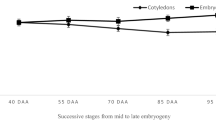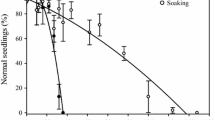Abstract
Mature and dried seeds from three species of the Acer genus, which differed in desiccation tolerance, were analyzed. The three species investigated were as follows: Acer platanoides L. (Norway maple, orthodox, A1 and A2 seedlots); Acer pseudoplatanus L. (sycamore, recalcitrant, B1 and B2 seedlots); and Acer saccharinum (silver maple, recalcitrant, C1 and C2 seedlots). We compared the appearance of dehydrins and small heat shock proteins in seedlots originating from cropping years that differed in weather conditions, which were monitored in detail during seed development. The experiments showed that three main dehydrins with approximate molecular weights of 46, 35, and 23 kDa were characteristic of all examined Acer species seeds. The three proteins were present in the A1 and A2 seedlots of the orthodox category Norway maple seeds and were noted either individually or together in the B1, B2, C1, and C2 seedlots of recalcitrant category seeds. It was found that one major small heat shock protein existed with a molecular mass of 22 kDa and was detectable at high concentrations in all seeds of the studied Acer species; after the seeds were dried, the content of this protein significantly increased. The potential modulation of dehydrin expression by environmental factors such as developmental heat sum and rainfall is discussed in the present work. The influence of water removal, which is caused by seed drying, in seeds of the same genus and belonging to the orthodox and recalcitrant categories is also explored.







Similar content being viewed by others
References
Almoguera C, Prieto-Dapena P, Díaz-Martín L, Espinosa JM, Carranco R, Jordano J (2009) The HaDREB2 transcription factor enhances basal thermo tolerance and longevity of seeds through functional interaction with HaHSFA9. BMC Plant Biol 9:75
Bae EK, LeeH Lee JS, Noh EW (2009) Differential expression of a poplar SK2-type dehydrin gene in response to various stresses. BMB Rep 42(7):439–443
Bailly C (1994) Active oxygen species and antioxidants in seed biology. Seed Sci Res 14:93–107
Battaglia M, Olvera-Carillo Y, Garciarubbio A, Campos F, Covarrubias A (2008) The enigmatic LEA proteins and other hydropilins. Plant Physiol 148:6–24
Beardmore T, Whitle CA (2005) Induction of tolerance to desiccation and cryopreservation of silver maple (Acer saccharinum) embryonic axes. Tree Physiol 25:965–972
Berjak P, Pammenter NW (1994) Recalcitrantis not an all-or-nothing situation. Seed Sci Res 4:263–264
Bettey M, Finch-Savage WE (1998) Stress protein content of mature Brassic anapus seeds and their germination performance. Seed Sci Res 8:347–355
Bradford MM (1976) A rapid and sensitive method for the quantitation of microgram quantities utilizing the principle of protein dye binding. Anal Biochem 72:248–254
Brini F, Hanin M, Lumbreras V, Irar S, Pagès M, Masmoudi K (2007) Functional characterization of DHN-5 a dehydrin showing a differential phosphorylation pattern in two Tunisian durum wheat (Triticum durum Desf.) varieties with marked differences in salt and drought tolerance. Plant Sci 172:20–28
Browne JA, Dolan KM, Tyson T, Goyal K, Tunnacliffe A, Burnell AM (2004) Dehydration-specific induction of hydrophilic protein genes in the anhydrobiotic nematode Aphelenchus avenae. Eukaryotic Cell 3(4):966–975
Buitink J, Claessens MMAE, Hemminga MA, Hoekstra FA (1998) Influence of water content and temperature on molecular mobility and intracellular glasses in seed and pollen. Plant Physiol 118:531–541
Close TJ (1996) Dehydrins: Emergence of a biochemical role of a family of plant dehydration proteins. Physiol Plant 97:795–803
Close TJ (1997) Dehydrins: A commonalty in the response of plants to dehydration and low temperature. Physiol Plant 100(2):291–296
Close TJ, Fenton RD, Moonan F (1993) A view of plant dehydrins using antibodies specific to the carboxy terminal peptide. Plant Mol Biol 23(2):279–286
Daws MI, Lydall E, Chmielarz P, Leprince O, Mathews S, Thanos CA, Pritchard HW (2004) Developmental heat sum influences recalcitrant seed traits in Aesculus hippocastanum across Europe. New Phytol 162:157–166
Daws MI, Cleland H, Chmielarz P, Gorian F, Leprince O, Mullins CE, Thanos CA, Vandvik V, Pritchard HW (2006) Variable desiccation tolerance in Acer pseudoplatanus seeds in relation to developmental condition: a case of phenotypic recalcitrance? Funct Plant Biol 33:59–66
DeRocher AE, Vierling E (1994) Developmental control of small heat shock protein expression during pea seed maturation. Plant J 5:93–102
Dickie JB, May K, Morris SVA, Titley SE (1991) The effect of desiccation on seed survival in Acer platanoides L. and Acer pseudoplatanus L. Seed Sci Res 1:149–162
Ellis RH, Hong TD, Roberts EH (1990) An intermediate category of seed storage behaviour? J Exp Bot 41:1167–1174
Finch-Savage WE, Blake PS (1994) Indeterminate development in desiccation-sensitive seeds of Quercus robur L. Seed Sci Res 4:127–133
Finch-Savage WE, Pramanik SK, Bewley JD (1994) The expression of dehydrin proteins in desiccation-sensitive (recalcitrant) seeds of temperate trees. Planta 193:478–485
Goyal K, Walton LJ, Tunnacliffe A (2005) LEA proteins prevent protein aggregation due to water stress. Biochem J 388:151–157
Greggains V, Finch-Savage WE, Quick WP, Atherton NM (2000) Putative desiccation tolerance mechanisms in orthodox and recalcitrant seeds of genus Acer. Seed Sci Res 10:317–327
Gutterman Y (2000) Maternal effect on seeds during development. In: Fenner M (ed) Seeds: The ecology of regeneration in plant communities, 2nd edn. Cabi Publishing, Wallingford, pp 59–84
Halsbeck M, Franzmann T, Weinfurtner D, Buchner J (2005) Some like it hot: the structure and function of small heat-shock proteins. Nat Struct Mol Biol 12(10):842–846
Hendrick JP, Hartl F-U (1995) The role of molecular chaperones in protein folding. FASEB J 9:1559–1569
Hoekstra FA, Golovina EA, Buitink J (2001) Mechanisms of plant desiccation tolerance. Trends Plant Sci 6(9):431–438
Hong TD, Ellis RH (1990) A comparison of maturation drying, germination and desiccation tolerance between developing seeds of Acer pseudoplatanus L. and Acer platanoides L. New Phytol 116:589–596
Hughes S, Graether SP (2011) Cryoprotective mechanism of a small intrinsically disordered dehydrin protein. Protein Sci 20(1):42–50
ISTA (1999) International rules for seed testing: rules 1999. Seed Sci Technol 27(Suppl):1–133
Jahnel H (1955) The stratification of forest seed. Angew Bot 29:134–141
Kalemba EM, Pukacka S (2007) Possible roles of LEA proteins and sHSPs in seed protection, a short review. Biol Lett 44:1–8
Kalemba EM, Pukacka S (2008) Changes in late embryogenesis abundant proteins and a small heat shock protein during storage of beech (Fagus sylvatica L.) seeds. Environ Exp Bot 63:274–280
Kalemba EM, Janowiak F, Pukacka S (2009) Desiccation tolerance acquisition in developing beech (Fagus sylvatica L.) seeds: the contribution of dehydrin-like protein. Trees 23:305–315
Kovacs D, Kalmar E, Torok Z, Tompa P (2008) Chaperone activity of ERD10 and ERD14, two disordered stress-related plant proteins. Plant Physiol 147:381–390
Laemmli UK (1970) Cleavage of structural proteins during the assembly of the head of bacteriophage T4. Nature 227:680–685
Manfre AJ, LaHatte GA, Climer CR, Marcotte WR Jr (2009) Seed dehydration and the establishment of desiccation tolerance during seed maturation is altered in the Arabidopsis thaliana mutant atem6-1. Plant Cell Physiol 50(2):243–253
Marian CO, Krebs SL, Arora R (2003) Dehydrin variability among rhododendron species: a 25-kDa dehydrin is conserved and associated with cold acclimation across diverse species. New Phytol 161:773–780
Nylander M, Svensson J, Palva ET, Welin BV (2001) Stress-induced accumulation and tissue specific localization of dehydrins in Arabidopsis thaliana. Plant Mol Biol 45:263–279
Panza V, Distéfano AJ, Carjuzaa P, Láinez V, Del Vas M, Maldonado S (2007) Detection of dehydrin-like proteins in embryos and endosperm of mature Euterpe edulis seeds. Protoplasma 231:1–5
Pukacka S (1998) Charakterystyka rozwoju nasion klonu zwyczajnego (Acer platanoides L.) i jaworu (Acer pseudoplatanus L.). Arboretum Kórnickie 43 (in Polish)
Pukacka S, Czubak A (1998) The effect of desiccation on viability and membrane lipid composition of Acer pseudoplatanus seeds. Acta Soc Bot Pol 67(3–4):249–252
Pukacka S, Ratajczak E (2006) Antioxidative response of ascorbate-glutathione pathway enzymes and metabolites to desiccation of recalcitrant Acer saccharinum seeds. J Plant Physiol 163:1259–1266
Pukacka S, Ratajczak E (2007) Ascorbate and glutathione metabolism during development and desiccation of orthodox and recalcitrant seeds of the genus Acer. Funct Plant Biol 34:601–613
Pukacka S, Wójkiewicz E (2002) Carbohydrate metabolism in Norway maple and sycamore seeds in relation to desiccation tolerance. J Plant Physiol 159:273–279
Pukacka S, Ratajczak E, Kalemba E (2011) The protective role of selenium in recalcitrant Acer saccharium L. seeds subjected to desiccation. J Plant Physiol 168(3):220–225
Richard S, Morency MJ, Drevet C, Jouanin L, Séguin A (2000) Isolation and characterization of a dehydrin gene from white spruce induced upon wounding, drought and cold stresses. Plant Mol Biol 43(1):1–10
Roberts EH (1973) Predicting the storage life of seeds. Seed Sci Technol 1:499–514
Rorat T (2006) Plant dehydrins–tissue location, structure and function. Cell Mol Biol Lett 11:536–556
Siddique M, Gernhard S, von Koskull-Döring P, Vierling E, Scharf KD (2008) The plant sHSP superfamily: five new members in Arabidopsis thaliana with unexpected properties. Cell Stress Chaperones 13(2):183–197
Sivamani E, Bahieldrin A, Wraith JM, Al-Niemi T, Dyer WE, Ho TH, Qu R (2000) Improved biomass productivity and water use efficiency under water deficit conditions in transgenic wheat constitutively expressing the barley HVA1 gene. Plant Sci 155:1–9
Sun W, Bernard C, Van de Cotte B, Van Montagu M, Verbruggen N (2001) At-HSP17.6A, encoding a small heat-shock protein in Arabidopsis, can enhance osmotolerance upon overexpression. Plant J 27:407–415
Sunderlíková V, Salaj J, Kopecky D, Salaj T, Wilhelm E, Matusikova I (2009) Dehydrin genes and their expression in recalcitrant oak (Quercus robur) embryos. Plant Cell Rep 28:1011–1021
Tunnacliffe A, Wise MJ (2007) The continuing conundrum of the LEA proteins. Naturwissenschaften 94:791–812
Vierling E (1997) The small heat shock proteins in plants are members of an ancient family of heat induced proteins. Acta Physiol Plant 19:539–547
Vornam B, Gailing O, Derory J, Plomion C, Kremer A, Finkeldey R (2011) Characterisation and natural variation of a dehydrin gene in Quercus petraea (Matt.) Liebl. Plant Biol. doi:10.1111/j.1438-8677.2011.00446.x
Waters ER, Lee GJ, Vierling E (1996) Evolution, structure and function of the small heat shock proteins in plants. J Exp Bot 47(296):325–338
Wehmeyer N, Hernandez LD, Finkelstein RR, Vierling E (1996) Synthesis of small heat-shock proteins is part of the developmental program of late seed maturation. Plant Physiol 112:747–757
Welin BV, Olson A, Nylander M, Palva ET (1994) Characterization and differential expression of dhn/lea/rab-like genes during cold acclimation and drought stress in Arabidopsis thaliana. Plant Mol Biol 26:131–144
Acknowledgments
The antisera raised against the K segment were kindly supplied by T.J. Close from the Department of Botany and Plant Sciences at the University of California, Riverside, CA, USA. The antisera raised against the Arabidopsis anti-Hsp17.4 were kindly supplied by E. Vierling from the Department of Biochemistry & Molecular Biophysics at the University of Arizona, Tucson, AZ, USA. This research was supported by The Ministry of Science and Information (Poland) (grant No. 2PO6L02927) and The Ministry of Science and Higher Education (Poland) (grant No. N N309 136535).
Author information
Authors and Affiliations
Corresponding author
Rights and permissions
About this article
Cite this article
Kalemba, E.M., Pukacka, S. Association of Protective Proteins with Dehydration and Desiccation of Orthodox and Recalcitrant Category Seeds of Three Acer Genus Species. J Plant Growth Regul 31, 351–362 (2012). https://doi.org/10.1007/s00344-011-9246-4
Received:
Accepted:
Published:
Issue Date:
DOI: https://doi.org/10.1007/s00344-011-9246-4




